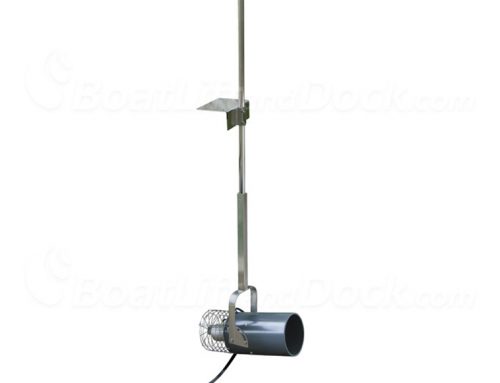“Load Guides” are a great option for anyone looking to provide some assistance to parking their watercraft on the lift or for inexperienced drivers. These guides are a great help when you lift is located in wavy or windy areas of the lake. Rivers can be especially difficult to park in when they are fast flowing and your lift is perpendicular to the flow of the water.
These load guides come in a variety of styles and variations to fit almost any desired look or function. From spring loaded foam guides, traditional carpet covered wood guides and the new glide rail systems provided by some manufacturers. It is very important that you match the model of your existing freestanding lift to the brand and size guides that are designed for that model.
The spring loaded foam guides are the most economical choice and are the best design for traditional v-hull and ski boats. With canvas covers over thick foam logs, these guides will not scratch the sides of your boat when entering or exiting the lift. Another great thing about these lifts is if you ever have to replace a foam log or cover they are both cheaper replacement parts than many other things on a lift.
Carpeted guides are the most traditional system. Most companies provide the aluminum mounting hardware to attach to their brand of lift and then the customer will provide their own wood and carpet. Marine carpet is available through many vendors and the treated lumber can be attained at most large lumber yards. Simply staple the marine carpet to the wood and attach the wood to the vertical load guide uprights. This style has the added benefit of acting as a step as you enter and exit your boat and the lift.
The newest design some companies are making is a guide rail system. These systems are vinyl covered and flare out at the entrance to the lift to give you maximum assistance in getting your boat into your lift properly. They can be mounted on the sides of the lift cradle like a traditional carpeted guide but if you have pontoons you can get them as a toon rail pontoon rack which acts as a guide and is the apparatus for lifting and lowering the boat to the water. It should be noted that most lifts support a traditional pontoon rack with vertical uprights and large wood planks between the front bad back of the cradle that then lifts the pontoon. These are load guides in a literal sense but as the guide rail system, they can act as a rudimentary guide on for pontoon lifts.
When deciding whether these systems are for you or not comes down to the wind, waves, and currents in your areas as well as the experience of the drivers involved.









